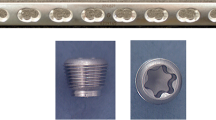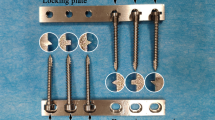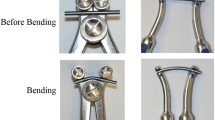Abstract
Purpose
This study compares the mechanical properties of low-cost stainless steel dynamic compression plates (DCPs) from developing-world manufacturers, adhering to varying manufacturing quality standards, with those of high-cost DCPs manufactured for use in the developed world.
Methods
Standard-design ten-hole DCPs from six developing-world manufacturers and high-cost DCPs from two manufacturers in the developed world were studied. Nine plates from each manufacturer underwent mechanical testing: six in four-point monotonic bending to assess strength and stiffness and three in four-point bending fatigue. Statistical comparisons of the group means of monotonic bending test data were made, and a qualitative comparison was performed to assess failures in fatigue.
Results
Low-cost DCPs from manufacturers with at least one manufacturing quality standard had significantly higher bending strength and fewer failures in fatigue than did those from low-cost manufacturers with no recognised quality standards. High-cost DCPs demonstrated greater bending strength than did those in both low-cost groups. There were no differences in stiffness and fatigue failure between high-cost DCPs and those low-cost DCPs with quality standards. However, high-cost DCPs were significantly less stiff and had fewer fatigue failures than low-cost DCPs manufactured without such standards.
Conclusion
Significant differences were found in the mechanical properties of ten-hole DCP plates from selected manufacturers in the developing and developed worlds. These differences correlated with reported quality certification in the manufacturing process. Mechanical analysis of low-cost implants may provide information useful in determining which manufacturers produce implants with the best potential for benefit relative to cost.





Similar content being viewed by others
References
Bhat AK, Rao SK, Bhaskaranand K (2006) Mechanical failure in intramedullary interlocking nails. J Orthop Surg (Hong Kong) 14:138–141
Gardner MJ, Evans JM, Dunbar RP (2009) Failure of fracture plate fixation. J Am Acad Orthop Surg 17:247–257
Azevedo C, Hippert EJ (2002) Failure analysis of surgical implants in Brazil. Eng Fail Anal 9:621–633
Mwangi JC, Admani AA (2011) Management of bilateral fracture femur with implant failure, a case report. East Afr Med J 5:58–62
ASTM (2008) Standard specification and test method for metallic bone plates - F382-99. American Society for Testing Materials, Philadelphia, PA
Strom AM, Garcia TC, Jandrey K, Huber ML, Stover SM (2010) In vitro mechanical comparison of 2.0 and 2.4 limited-contact dynamic compression plates and 2.0 dynamic compression plates of different thicknesses. Vet Surg 39:824–828
Hammel SP, Elizabeth Pluhar G, Novo RE, Bourgeault CA, Wallace LJ (2006) Fatigue analysis of plates used for fracture stabilization in small dogs and cats. Vet Surg 35:573–578
Brunner H, Simpson JP (1980) Fatigue fracture of bone plates. Injury 11:203–207
Kanchanomai C, Phiphobomongkol V, Muanjan P (2008) Fatigue failure of an orthopedic implant—a locking compression plate. Eng Fail Anal 15:521–530
Olender G, Pfeifer R, Muller CW, Gosling T, Barcikowski S, Hurschler C (2011) A preliminary study of bending stiffness alteration in shape changing nitinol plates for fracture fixation. Ann Biomed Eng 39:1546–1554
Sivakumar M, Dhanadurai S, Rajeswari S (1995) Failures in stainless steel orthopaedic implant devices: a survey. J Mater Sci Lett 14:351–354
Triantafyllidis G, Kazantzis A, Karageorgiou K (2007) Premature fracture of a stainless steel 316L orthopaedic plate implant by alternative episodes of fatigue and cleavage decoherence. Eng Fail Anal 14:1346–1350
Uhl JM, Seguin B, Kapatkin AS, Schulz KS, Garcia TC, Stover SM (2008) Mechanical comparison of 3.5 mm broad dynamic compression plate, broad limited-contact dynamic compression plate, and narrow locking compression plate systems using interfragmentary gap models. Vet Surg 37:663–673
Sauer H, Jungbluth K, Dumbleton J (1981) Compression plating of fracture of the femoral midshaft. In: Black J, Dumbleton JH (eds) Clinical biomechanics: a case history approach. Churchill Livingstone, Inc, New York, pp 201–229
Frost HM (1973) Orthopaedic biomechanics: orthopaedic lectures. Charles C. Thomas, Springfield, pp 367–449
Proverbio E, Bonaccorsi L (2011) Microstructural analysis of failure of stainless steel bone plate implant. Pract Fail Anal 1:33–38
Aluede EE, Phillips J, Bleyer J, Jergesen HE, Richard Coughlin RR (2012) Representation of developing countries in orthopaedic journals: a survey of four influential orthopaedic journals. Clin Orthop Relat Res 470:2313–2318
Acknowledgments
The institution of the authors has received funding from AO Synthes, which helped fund this research.
Conflict of interest
The authors declare that they have no conflict of interest.
Author information
Authors and Affiliations
Corresponding author
Appendix
Appendix
-
i)
International Organization for Standards (ISO) 9001 is a Quality Management System (QMS) that describes the requirements that manufacturing organizations must fulfill to meet the needs of consumers. This standard requires third party certification to confirm independently that the ISO 9001 requirements are met.
-
ii)
ISO 13485: This certification contains requirements for a comprehensive quality management system specific for the design and manufacture of medical devices. It requires that the quality system be implemented and maintained. Unlike ISO 9001, it does not require a third party to confirm continued compliance.
-
iii)
GMP: Good Manufacturing Practice requirements represent a quality management system covering the manufacture of medical devices. GMP covers aspects of production and testing that can have an impact on the quality of a product, involving processes in design, manufacture, packaging, labeling, storage, installation, and servicing of all finished devices intended for human use. This certification is issued locally, and designated cGMP if current.
-
iv)
Medical Device Directive (MDD) 93/42/EEC: this guideline ensures that devices are designed and manufactured in a way that does not compromise the clinical condition or safety of a patient and that they fulfill the manufacturer’s intended purpose. It requires manufacturers to demonstrate safety, quality, and efficacy before their product can be sold to consumers.
-
v)
European Conformity (CE): This certification is issued by an independent certification body after verification that a medical device manufacturer is in compliance with MDD 93/42/EEC.
-
a.
CNC: Issued by a German certification company in compliance with Medical Device Directive MDD 93/42/EEC.
-
b.
CE 1293: Issued by a Chinese certification company in compliance with MDD 93/42/EEC.
-
c.
CE 0086: Issued by a UK certification company in compliance with MDD 93/42/EEC.
-
d.
CE 1023: Issued by a Czech Republic certification company in compliance with MDD 93/42/EEC.
-
e.
CE 0434: Issued by a Norwegian certification company in compliance with MDD 93/42/EEC.
-
a.
Rights and permissions
About this article
Cite this article
Aluede, E., McDonald, E., Jergesen, H. et al. Mechanical behaviour of low-cost dynamic compression plates correlates with manufacturing quality standards. International Orthopaedics (SICOT) 38, 141–147 (2014). https://doi.org/10.1007/s00264-013-2148-2
Received:
Accepted:
Published:
Issue Date:
DOI: https://doi.org/10.1007/s00264-013-2148-2




